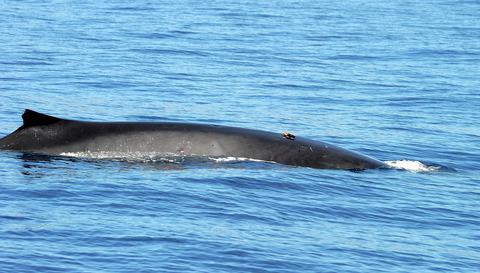当前位置:
X-MOL 学术
›
Funct. Ecol.
›
论文详情
Our official English website, www.x-mol.net, welcomes your
feedback! (Note: you will need to create a separate account there.)
The advantages of diving deep: fin whales quadruple their energy intake when targeting deep krill patches
Functional Ecology ( IF 4.6 ) Pub Date : 2019-11-05 , DOI: 10.1111/1365-2435.13471 Ari S. Friedlaender 1, 2 , Matthew T. Bowers 2, 3 , David Cade 4 , Elliott L. Hazen 1, 5 , Alison K. Stimpert 6 , Ann N. Allen 7 , John Calambokidis 8 , James Fahlbusch 4, 8 , Paolo Segre 4 , Fleur Visser 9 , Brandon L. Southall 2 , Jeremy A. Goldbogen 4
Functional Ecology ( IF 4.6 ) Pub Date : 2019-11-05 , DOI: 10.1111/1365-2435.13471 Ari S. Friedlaender 1, 2 , Matthew T. Bowers 2, 3 , David Cade 4 , Elliott L. Hazen 1, 5 , Alison K. Stimpert 6 , Ann N. Allen 7 , John Calambokidis 8 , James Fahlbusch 4, 8 , Paolo Segre 4 , Fleur Visser 9 , Brandon L. Southall 2 , Jeremy A. Goldbogen 4
Affiliation

|
How predators maximize energetic gains while minimizing the costs associated with exploiting heterogeneous prey remains a difficult ecological principle to test in natural systems. Deep‐diving, air‐breathing predators face conflicting demands of oxygen conservation to extend dive time and oxygen usage from the exercise required to find and capture prey. How predators balance these opposing factors is additionally complicated by prey patches that are heterogeneous spatially, temporally and in quality. Tags deployed on foraging fin whales revealed that deeper dives consisted of higher feeding rates (lunges/hr), as generally predicted by optimal foraging theory. By simultaneously measuring prey density and distribution in the local environment, we show that whales increased their dive depths in order to forage on the densest prey patches. Despite the increased travel time needed to find deeper prey during a breath‐hold dive, the increase in feeding rates of fin whales and modelled prey consumption quadrupled compared to shallow foraging. Because the cost of transport is low at this extreme in body size, we posit that feeding on the deep prey patches significantly increases the energetic efficiency of foraging. Given the increasing recognition that anthropogenic disturbance can curtail deep foraging dives in many cetacean species, endangered fin whales may be susceptible to significant energetic losses that may impact individual fitness and population health in some areas. A free Plain Language Summary can be found within the Supporting Information of this article.
中文翻译:

深潜的优势:当瞄准深磷虾斑块时,长须鲸的能量摄入量增加了四倍
捕食者如何最大化能量收益同时最小化与利用异质猎物相关的成本仍然是一个难以在自然系统中测试的生态学原理。深潜、呼吸空气的捕食者面临着相互矛盾的氧气保护需求,以延长潜水时间和氧气使用量,以便寻找和捕获猎物所需的运动。捕食者如何平衡这些对立因素也变得复杂,因为猎物在空间、时间和质量上都是异质的。部署在觅食长须鲸上的标签表明,正如最佳觅食理论通常预测的那样,更深的潜水包括更高的进食率(弓步/小时)。通过同时测量当地环境中的猎物密度和分布,我们表明鲸鱼增加了潜水深度,以便在最密集的猎物块上觅食。尽管在屏气潜水期间寻找更深的猎物需要增加旅行时间,但与浅层觅食相比,长须鲸的摄食率和模拟猎物消耗量增加了四倍。由于在这种极端的体型下运输成本很低,我们假设以深部猎物为食可以显着提高觅食的能量效率。鉴于人们越来越认识到人为干扰会减少许多鲸类物种的深度觅食潜水,濒临灭绝的长须鲸可能容易受到重大能量损失的影响,这可能会影响某些地区的个体健康和人口健康。可以在本文的支持信息中找到免费的普通语言摘要。与浅层觅食相比,长须鲸的摄食率和模拟猎物消耗量增加了四倍。由于在这种极端的体型下运输成本很低,我们假设以深部猎物为食可以显着提高觅食的能量效率。鉴于人们越来越认识到人为干扰会减少许多鲸类物种的深度觅食潜水,濒临灭绝的长须鲸可能容易受到重大能量损失的影响,这可能会影响某些地区的个体健康和人口健康。可以在本文的支持信息中找到免费的普通语言摘要。与浅层觅食相比,长须鲸的摄食率和模拟猎物消耗量增加了四倍。由于在这种极端的体型下运输成本很低,我们假设以深部猎物为食可以显着提高觅食的能量效率。鉴于人们越来越认识到人为干扰会减少许多鲸类物种的深度觅食潜水,濒临灭绝的长须鲸可能容易受到重大能量损失的影响,这可能会影响某些地区的个体健康和人口健康。可以在本文的支持信息中找到免费的普通语言摘要。我们假设以深部猎物块为食可显着提高觅食的能量效率。鉴于人们越来越认识到人为干扰会减少许多鲸类物种的深度觅食潜水,濒临灭绝的长须鲸可能容易受到重大能量损失的影响,这可能会影响某些地区的个体健康和人口健康。可以在本文的支持信息中找到免费的普通语言摘要。我们假设以深部猎物块为食可显着提高觅食的能量效率。鉴于人们越来越认识到人为干扰会减少许多鲸类物种的深度觅食潜水,濒临灭绝的长须鲸可能容易受到重大能量损失的影响,这可能会影响某些地区的个体健康和人口健康。可以在本文的支持信息中找到免费的普通语言摘要。
更新日期:2019-11-05
中文翻译:

深潜的优势:当瞄准深磷虾斑块时,长须鲸的能量摄入量增加了四倍
捕食者如何最大化能量收益同时最小化与利用异质猎物相关的成本仍然是一个难以在自然系统中测试的生态学原理。深潜、呼吸空气的捕食者面临着相互矛盾的氧气保护需求,以延长潜水时间和氧气使用量,以便寻找和捕获猎物所需的运动。捕食者如何平衡这些对立因素也变得复杂,因为猎物在空间、时间和质量上都是异质的。部署在觅食长须鲸上的标签表明,正如最佳觅食理论通常预测的那样,更深的潜水包括更高的进食率(弓步/小时)。通过同时测量当地环境中的猎物密度和分布,我们表明鲸鱼增加了潜水深度,以便在最密集的猎物块上觅食。尽管在屏气潜水期间寻找更深的猎物需要增加旅行时间,但与浅层觅食相比,长须鲸的摄食率和模拟猎物消耗量增加了四倍。由于在这种极端的体型下运输成本很低,我们假设以深部猎物为食可以显着提高觅食的能量效率。鉴于人们越来越认识到人为干扰会减少许多鲸类物种的深度觅食潜水,濒临灭绝的长须鲸可能容易受到重大能量损失的影响,这可能会影响某些地区的个体健康和人口健康。可以在本文的支持信息中找到免费的普通语言摘要。与浅层觅食相比,长须鲸的摄食率和模拟猎物消耗量增加了四倍。由于在这种极端的体型下运输成本很低,我们假设以深部猎物为食可以显着提高觅食的能量效率。鉴于人们越来越认识到人为干扰会减少许多鲸类物种的深度觅食潜水,濒临灭绝的长须鲸可能容易受到重大能量损失的影响,这可能会影响某些地区的个体健康和人口健康。可以在本文的支持信息中找到免费的普通语言摘要。与浅层觅食相比,长须鲸的摄食率和模拟猎物消耗量增加了四倍。由于在这种极端的体型下运输成本很低,我们假设以深部猎物为食可以显着提高觅食的能量效率。鉴于人们越来越认识到人为干扰会减少许多鲸类物种的深度觅食潜水,濒临灭绝的长须鲸可能容易受到重大能量损失的影响,这可能会影响某些地区的个体健康和人口健康。可以在本文的支持信息中找到免费的普通语言摘要。我们假设以深部猎物块为食可显着提高觅食的能量效率。鉴于人们越来越认识到人为干扰会减少许多鲸类物种的深度觅食潜水,濒临灭绝的长须鲸可能容易受到重大能量损失的影响,这可能会影响某些地区的个体健康和人口健康。可以在本文的支持信息中找到免费的普通语言摘要。我们假设以深部猎物块为食可显着提高觅食的能量效率。鉴于人们越来越认识到人为干扰会减少许多鲸类物种的深度觅食潜水,濒临灭绝的长须鲸可能容易受到重大能量损失的影响,这可能会影响某些地区的个体健康和人口健康。可以在本文的支持信息中找到免费的普通语言摘要。











































 京公网安备 11010802027423号
京公网安备 11010802027423号